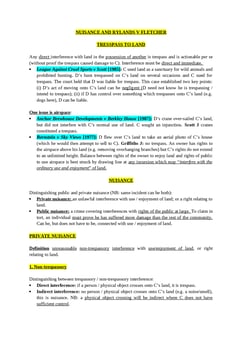Phipps v Rochester [1955] 1 QB 450
Judgement for the case Phipps v Rochester
Table Of Contents
KEY POINTS
In a situation of dangerous premises, the key responsivities are the Licensor (often the property owner or manager) and the Licensee (those granted permission to access the property). The Licensor bears the responsibility of ensuring premises safety, while the Licensee relies on this assurance.
Defining a "little child" in negligence is pivotal, as it determines the care owed to children visiting. Children might not grasp risks fully, intensifying the Licensor's duty to protect them from potential hazards.
Child status as a licensee is vital when they enter a property with permission, implying the Licensor's duty to warn or safeguard against hidden dangers. An open, unfenced trench underscores this need for caution. When children are unaccompanied, the Licensor's duty is magnified, emphasizing proactive safety measures.
The occupier's duty in negligence within dangerous premises highlights the importance of vigilance and collaboration between Licensor and Licensee to safeguard child visitors effectively.
FACTS
On an October evening, a five-year-old boy and his seven-year-old sister were blackberry picking. They crossed a large open grassland, part of a housing estate under development by the defendants. In this grassland, a deep trench had been dug for a sewer, causing the boy to fall in and break his leg.
The children lived nearby, and it was common for kids to play there.
The defendants didn't take precautions to restrict access, but there was no evidence of young children frequenting the area.
JUDGEMENT
Children were allowed to play on the grassland. The trench was a hidden danger for young children.
A landowner must assume young children may use their land. Responsible parents usually protect their children from known dangers or provide warnings.
The landowner's responsibility increased if they knew children went unsupervised to specific areas. Parents bear the primary responsibility for child safety. The defendants weren't expected to anticipate very young children playing alone on the land.
Assuming parents act prudently, the landowner wasn't liable as a licensee for the child's injury.
COMMENTARY
An incident occurred on an October evening when a five-year-old boy and his seven-year-old sister ventured out for blackberry picking. They went to a grass field which was part of a housing estate being developed by the defendants.
The boy stumbled into a trench on the grassfield, resulting in a severe leg injury.
The children resided near this open grassland, and it was common for local kids to spend time there. The defendants had taken no measures to prevent access to this area. However, crucially, there was no concrete evidence suggesting that very young children frequently played in this area.
The judgment rendered some key points. It emphasized that children, as a general group, were implicitly permitted to play on the grassland, highlighting the notion of implied license.
Though not inherently hidden from the view of adults or older children, the trench posed an invisible danger to a child of the plaintiff's age. This underscored that certain hazards may be inconspicuous to very young children.
It clarified that a landowner who allowed public use of their land without distinction among users must assume that young children may also utilize the space. However, the landowner could reasonably expect that responsible parents would not knowingly expose their children to danger. As a customary practice, fulfilling the duty included warning or making obvious dangers comprehensible to guardians.
If the landowner knew or should have foreseen that children were accessing specific areas on their land unaccompanied, they might be obligated to take additional precautions. Nonetheless, the primary responsibility for ensuring young children's safety rested on their parents' shoulders, who were expected to prevent unsupervised wandering and verify the safety of areas where their children played independently.
The judgment noted that the defendants were not expected to foresee that young children would be sent to play alone on the open grassland. The assumption was that parents would naturally exercise prudence and ensure the safety of areas they allowed their children to access without supervision.
The judgment absolved the defendants of liability as licensees for the child's injury, underlining the importance of parental responsibility and the reasonable expectations of landowners.
ORIGINAL ANALYSIS
Defendant tacitly permitted people to enter his land (he knew of it and did not mind) and Plaintiff, a small child, entered the land and fell in a trench that Defendant had dug for building work, injuring himself. Plaintiff sued Defendant.
Devlin J dismissed Plaintiff’s claim.
Devlin J
The trench would have been no danger to an adult or large child: only a small child was endangered since he could not have realised how dangerous it was.
The general rule is that if a landowner permits the general public to use his land he will have discharged his duty of care if the dangers are obvious to a guardian (of children) or he has given a warning comprehensible to the guardian.
The exception is if the landowner knows or ought to know that young children are using his land unaccompanied, in which case he should take steps accordingly. This isn’t the case here.
For Further Study on Phipps v Rochester
Need instant answers? Our AI exam tutor is here to help.
Ask questions 🙋 Get answers 📔 It's simple 👁️👄👁️
Our AI is educated by the highest scoring students across all subjects and schools. Join hundreds of your peers today.
Get StartedSimilar Cases
Related Product Samples
These product samples contain the same concepts we cover in this case.
| Tort Law | Occupier's Liability Notes (27 pages) |

 Since 2010, Oxbridge Notes has been a trusted education marketplace, supplying high-quality materials from top achievers at universities like Oxford, Cambridge, LSE, Harvard, and Yale.
Since 2010, Oxbridge Notes has been a trusted education marketplace, supplying high-quality materials from top achievers at universities like Oxford, Cambridge, LSE, Harvard, and Yale.